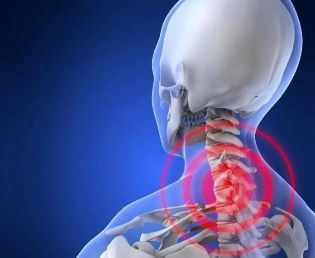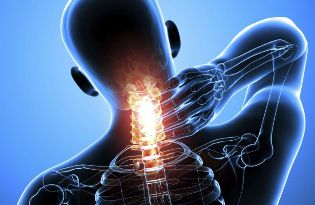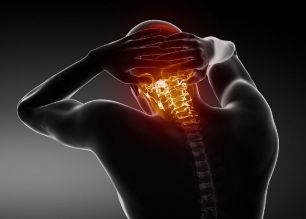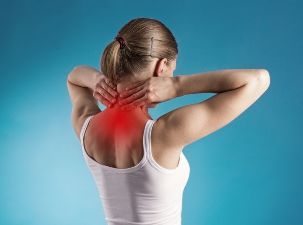Diseases of the spine invariably remain at the top of the list of the most common diseases of the 21st century. The first line, in most cases, belongs to the diagnosis: osteochondrosis of the cervical spine - a dangerous ailment that requires the mandatory intervention of experienced doctors.
The disease spares no one, neither women nor men (clinical cases of cervical osteochondrosis in men are recorded less often than in women, but they do occur). In addition, the disease "rejuvenates" every year, today signs of cervical osteochondrosis can be observed not only in those who have passed the age of 40, but also in those who turned 25 only yesterday.
What is osteochondrosis of the cervical spine, what serves as a catalyst for the onset of the development of this disease, why an epidemic called osteochondrosis of the cervical vertebrae is gaining momentum, what symptoms of cervical osteochondrosis should be a reasonfor a visit to a medical institution, how not to be at risk and eat a chance to get rid of cervical osteochondrosis forever? For those looking for answers to these questions, this article is intended. So, first thing.

General information about the disease
This disorder can be characterized in one word: dystrophy. It arises against the background of changes in the chemical composition of bone and cartilage tissue and entails a loss of elasticity and strength by the elements of the spine (discs). Their structure changes, initially the outer layer (fibrous ring) is destroyed, then the inner layer (nucleus pulposus). A disc (fibrous cartilage) that has completely lost its properties can be deformed, covered with growths (osteophytes) and displaced.
The discs, changing shape, size and position, pinch the nerve roots (they can injure one of the 8 pairs of spinal nerves located in this area) or the blood channels (the arteries responsible for feeding the brain pass through this area). . . In both the first and second cases, the symptoms of osteochondrosis of the cervical spine are clearly felt.
Cervical osteochondrosis is the most common diagnosis that a neurologist or vertebrologist should make to his patients. Osteochondrosis of the cervical vertebra, as the most common reason for visiting a doctor, is a consequence of two reasons:
- Anatomical features. The vulnerability of the upper part of the crest is associated with the miniature and the fragility of its connecting elements (vertebrae, discs).
- Serious loads. The neck is responsible for both mobility and stability at the same time. This can only lead to rapid "wear" of the weak links.
This is why the question: is cervical osteochondrosis treated? worries many.
Causes of the disease
Before moving on to the point: how to cure cervical osteochondrosis, you should understand the causes of its occurrence and try to rule out the factors that can trigger the onset of its development.

It is not possible to give a complete list of catalysts, but it is quite possible to outline the moments that can lead to the fact that the signs of osteochondrosis of the cervical spine will not keep you waiting.
The main causes of osteochondrosis:
- unhealthy diet (snacks on the run, fast food, lack of a regimen and complete and balanced food in the diet - this is a direct path to the exhaustion of cartilage and bone tissue, which does not receive enough trace elements and vitaminsthat support his health);
- sedentary lifestyle (another possible option is the lack of physical activity, it causes stagnation of the elements of the ridge and the lack of an adequate supply of oxygen to the tissues);
- genetic predisposition (in this case, you can ask your parents what to do with cervical osteochondrosis, they will tell you how to get rid of osteochondrosis of the cervical spine and how this ailment manifests itself);
- postponed lesions (the need to obtain information on what cervical osteochondrosis is can also occur when the development of this disease was the result of displacement or rupture of the intervertebral discs as a result of injury);
- diseases of the vascular system, of an infectious or inflammatory nature (in the first case, information on the topic: how to treat osteochondrosis of the cervical spine occurs due to a lack of nutrients that support cartilage tissue, in the second, to faultof autoimmune and necrotic processes that destroy joints, vertebrae and discs).
The instability of the hormonal background caused by situations of overweight or stress, as well as poor posture (scoliosis) are two more reasons to familiarize yourself with the materials on the case: it is possible to cure osteochondrosis of the cervical spine.
Signs of disease
The causes of cervical osteochondrosis are established. The work on insects is done. Now the most important thing is not to miss the symptoms of osteochondrosis of the neck (in case the risk factors were eliminated too late and the disease has already begun to manifest itself). The sooner they are diagnosed, the easier and faster the road to recovery will be.
For convenience, it is convenient to divide all signs of the disease into two groups. This can be done according to the main criterion - the origin.
The first group is the phenomenon, the appearance of which is caused by the blockage of the blood arteries (caused by vascular alterations). Compressed channels for the transport of blood, saturated with oxygen and nutrients, cannot fully cope with their task, parts of the brain receive less nutrition and lose some of their functional capabilities.

The second group consists of symptoms, the manifestation of which is associated with pinched nerve endings (caused by neurological changes). In most cases, the vagus nerve (which coordinates the state of the esophagus, pharynx and larynx), the phrenic nerve (responsible for heart rate and regulation of the respiratory process), as well as the nerve endings that innervate other organs of the internal structure, suffer from deformation, destruction and mixing of discs and vertebrae.
More detailed information on how not to miss the first "bells" of the disease in case of osteochondrosis of the cervical spine and on the timely use of the help that the attending physician can offer is presented in the table below.
Symptoms of the disease
| Source | Manifestations |
|---|---|
| Changes in the state of the vascular system | dizziness, fainting lack of coordination memory impairment decreased concentration of attention loss of visual acuity and hearing blackheads before eyes ringing, tinnitus apathy, depression panic attacks nausea, vomiting |
| Neurological changes | pain in neck, temples, occiput (constant, paroxysmal) pain radiating to arm, shoulder, interscapular region, chest shortness of breath, shortness of breath, suffocation pressure, chest tightness, angina lump in throat, difficulty in swallowing, dryness, itchy throat |
Important! If at least one symptom from the table above appears, it is necessary to urgently undergo an examination and begin treatment of osteochondrosis of the cervical spine. Any other behavior can lead to more serious consequences, which cannot be cured without surgery!
Complex therapy
How to treat cervical osteochondrosis, this is how the sore question sounds. The answer is unequivocal: with the help of complex therapy prescribed by a competent qualified doctor.
Fighting this ailment requires discipline from the patient and strict adherence to the recommendations of a specialist. In most cases, osteochondrosis of the cervical spine can be cured with the help of several methods of traditional and alternative medicine at the same time (only the doctor who coordinates the patient can determine a specific program aimed at the effective treatment of cervical osteochondrosis).
Typically chooses techniques from the following list:
physical therapy

Physiotherapy is an excellent tool for health therapy that allows you to both treat osteochondrosis of the cervical spine and improve your overall health. Solves several problems simultaneously:
- normalizes blood circulation;
- accelerates metabolic processes;
- relieves pain syndrome;
- strengthens the muscle corset;
- unloads the spine;
- accuses of cheerfulness and optimism.
There are a number of rules that explain how to get rid of cervical osteochondrosis by loading correctly, without making the situation worse. They read:
- the set of exercises should be selected by a specialist who has an idea of the general clinical picture (age, chronic diseases and characteristics of the patient);
- any discomfort during classes should become a reason for refusing gymnastics (at least before consulting a doctor), as well as a period of exacerbation of the disease;
- too active sudden movements are completely excluded, you need to do it carefully, without haste; The
- exercises should be performed regularly (exercising from time to time will not solve the problem).
Massage (manual therapy)
Is it possible to treat cervical osteochondrosis in another way? Enough. All you need to activate the body's regenerative properties, relieve spasms, free nerve roots, pinch arteries and reduce symptoms are the skilled hands of a great masseur or manual.
The general guidelines are:
- the procedure must be performed by a specialist with adequate training and experience;
- time of exposure to the problem area - no more than 35 minutes;
- duration of a course (without interruption) - no more than 12 sessions;
- any change in the patient's condition should be known to the treating physician.
Important! Make a massage for osteochondrosis or visit a therapist's office - a manual with contraindications is strictly prohibited!
Physiotherapy

This area of clinical medicine has found its answer to the question: how to get rid of osteochondrosis? He suggests using the healing properties of various phenomena, including:
- high frequency sound waves (ultrasound);
- mechanical vibrations (vibration);
- electric currents of varying intensity (electrophoresis, UHF);
- ultraviolet radiation (quartz);
- other physiotherapy techniques.
These procedures contribute to the onset of positive dynamics. They normalize blood flow, relieve inflammation, relieve pain, facilitate the administration of drugs and reduce the time required for their absorption by the tissues.
Medication
How to deal with cervical osteochondrosis, which continues to progress despite all attempts to stop this process? Only with the help of drugs designed to eliminate the causes of this phenomenon.
All medicines used in an integrated approach are divided into several groups, depending on the action taken. The following table will help clarify the situation.
Medicines
| Group | Action | |
|---|---|---|
| Analgesics, NSAIDs | pain relief, elimination of the inflammatory process |
|
| Muscle relaxants |
relief from muscle spasms | |
| Chondroprotector | activation of the tissue regeneration function, restoration of the structure of discs, vertebrae, joints |
|
| Vitamins and minerals |
stimulation of metabolic processes, activation of the protective properties of the body, better microcirculation, strengthen the immune system, |
The specialist decides for himself how to treat osteochondrosis of the neck. It can supplement therapy with drugs belonging to the group of vasodilators (to relieve vasodilators), antidepressants (to relieve nervous tension) and others, depending on the general clinical picture of the disease.
In summary, we can give a single answer to the main question: is osteochondrosis treated? Yes, but only under the close supervision of a competent doctor and with the great desire of the patient himself!





































